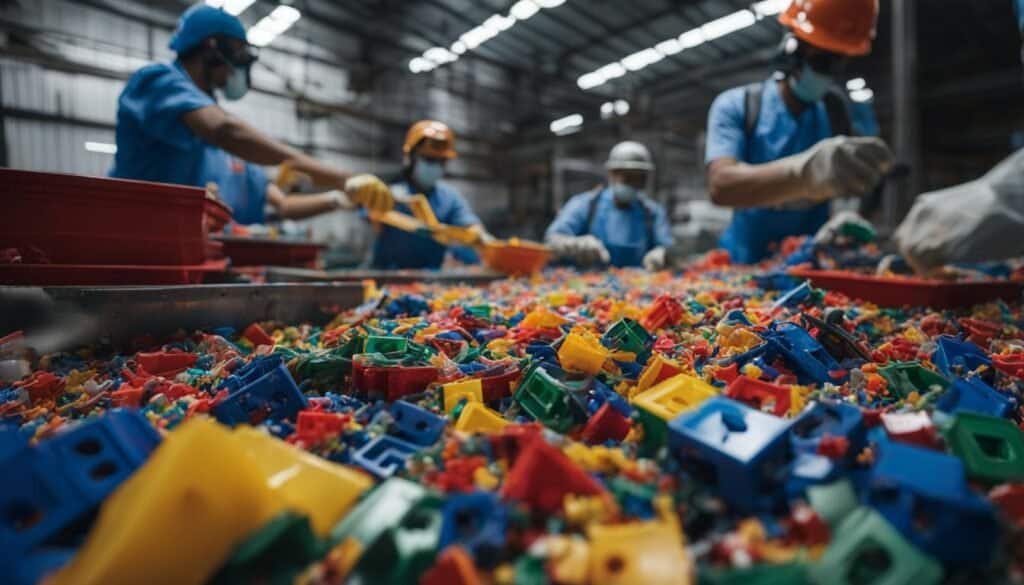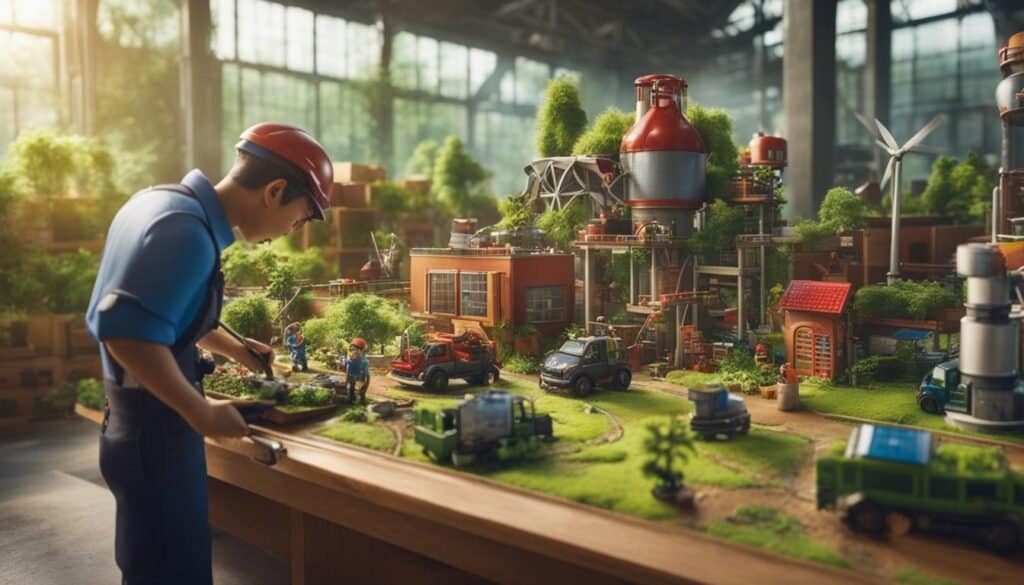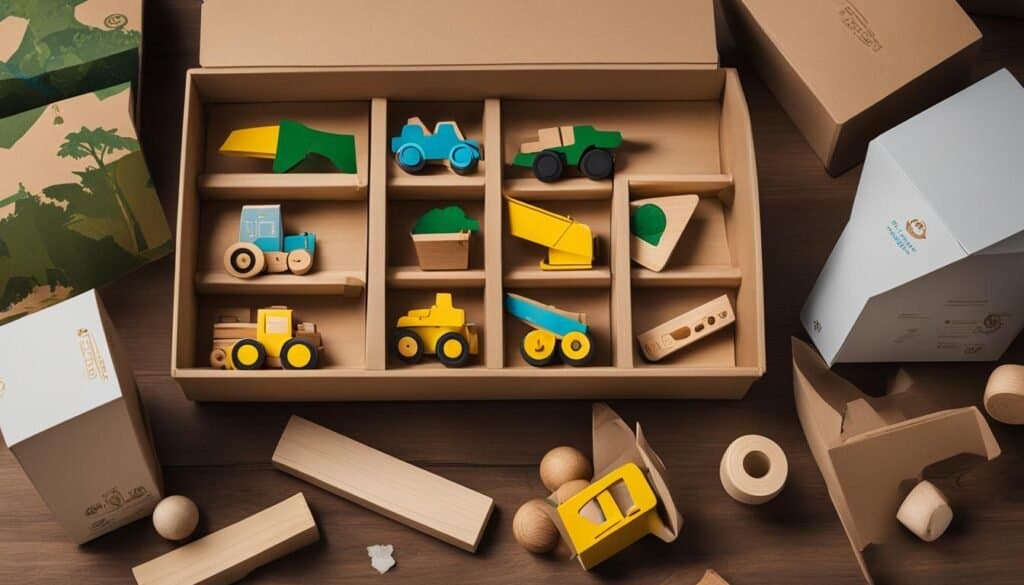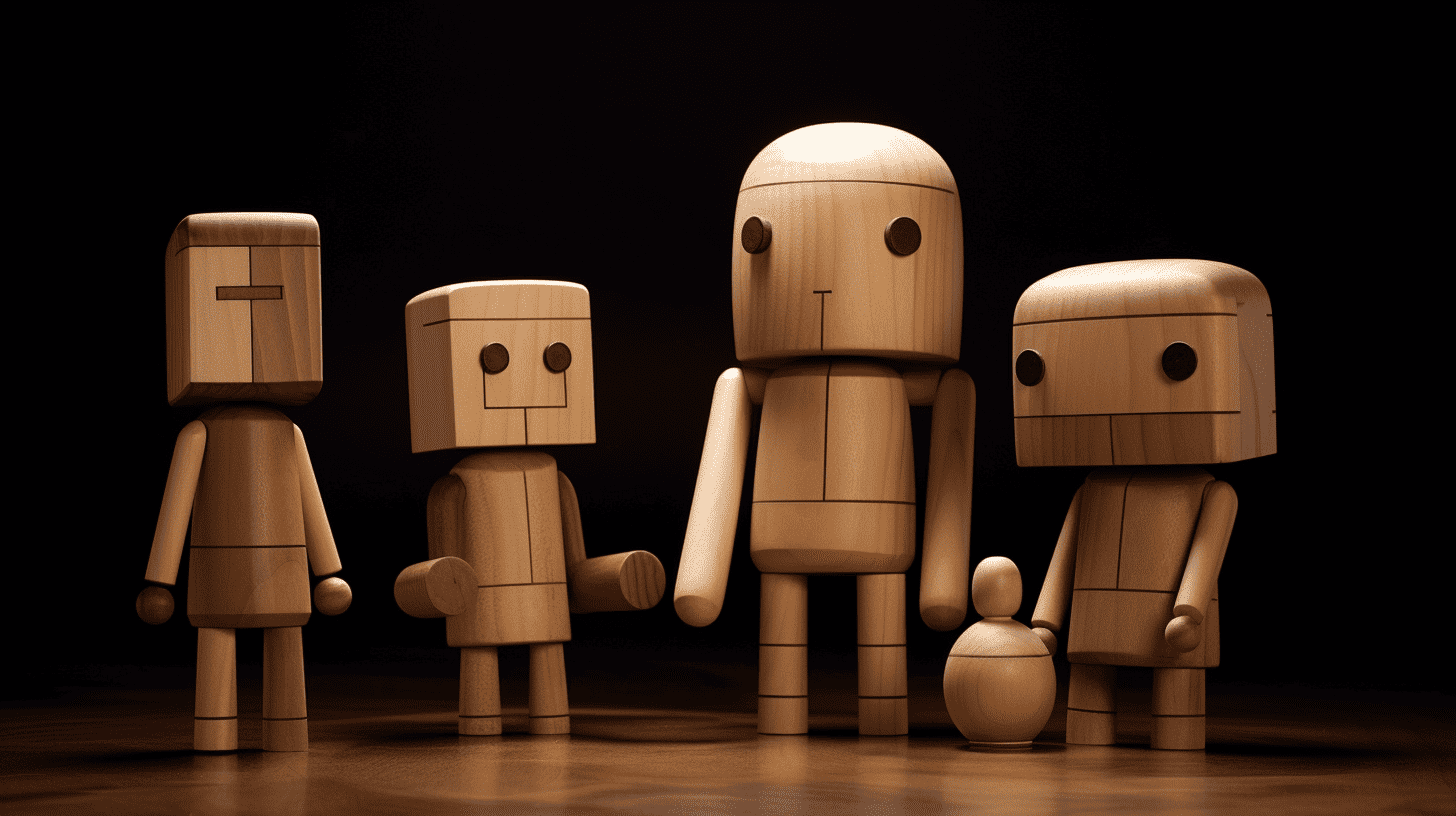As a parent, my search for safe, non-toxic toys for my children has turned into a journey of discovering fantastic eco-friendly toy brands that prioritize both the health of our planet and, of course, our kids. Brands like Senger Naturwelt, Grimms, Ostheimer, and Green Toys have caught my attention, showcasing amazing products crafted from environmentally friendly materials for toys such as sheep’s wool, cotton, and sustainable wood, all while featuring non-toxic colors.
With a focus on sustainable toy production, these brands offer creative play options like handcrafted stuffed animals, wooden blocks, puzzles, and imaginative sets that encourage children to explore, learn social interaction, and develop motor skills. I’m thrilled to see the transition from plastic to eco-friendly materials is transforming the toy industry into a more sustainable realm, allowing us to make mindful choices that contribute positively to our environment while promoting healthier lifestyles for our kids.
Key Takeaways
- Eco-friendly toy brands prioritize the planet’s health and children’s well-being.
- Environmentally friendly materials for toys include sheep’s wool, cotton, and sustainable wood.
- Non-toxic colors and finishes make toys safer for children.
- Green toys offer a wide range of play options that support learning and development.
- Sustainable toy production contributes to a healthier environment and lifestyle for future generations.
Embracing Sustainability: The Rise of Eco-Friendly Toy Brands
The shift from traditional toy production to sustainable methods is marked by an increased use of eco-friendly materials and a focus on recycling. Brands like Plan Toys prioritize rubberwood from non-latex-producing trees, demonstrating resourcefulness in material choice. Wobbel and Tender Leaf Toys utilize sustainably sourced wood and water-based finishes, emphasizing their contribution to environmental stewardship.
Ethically Engineered suggests that the best eco-friendly toys are made from sustainable materials such as recycled plastic, rubberwood, and organic cotton, which are not only biodegradable but also help in reducing plastic waste.
Production practices are also undergoing a change, with brands implementing eco-friendly manufacturing processes that minimize carbon footprints and prioritize the use of recycled materials. This transition from traditional to sustainable toy production is paving the way for greener and healthier playtime options for children.
Transitioning from Traditional to Sustainable Toy Production
Eco-friendly toys have a significant positive impact on both the environment and children’s health. By reducing the demand for new plastic production, brands like Green Toys divert waste from landfills and repurpose materials such as recycled plastic milk jugs, creating safe, robust play items free from BPA, phthalates, or PVC. The use of natural materials like organic cotton and beeswax in products from brands like Honeysticks and Cuddle + Kind not only ensures toys are non-toxic and safe for children but also promotes the sustainability of resources and encourages ethical production standards.
Parents are increasingly making the conscious decision to choose sustainable toy options as environmental awareness grows. – Environmentally-conscious parents
Consumer Shift: Why More Parents are Choosing Sustainable Options
Factors influencing this shift towards sustainable toy choices include:
- Desire for quality toys that can be passed down through generations
- Preference for materials that are non-toxic and safe for children
- Recognition of the importance of responsible manufacturing practices
Brands making strides in this direction, like Le Toy Van and Tegu, offer toys that are not only entertaining and developmentally beneficial but also align with the values of eco-conscious parents. By choosing sustainable options while making eco-friendly toy purchasing decisions, environmentally-conscious parents can make a positive impact on the environment and their children’s health.
| Traditional Toy Production | Sustainable Toy Production |
|---|---|
| Use of synthetic plastic materials | Use of eco-friendly materials like rubberwood, cotton, and beeswax |
| Higher carbon footprint due to extensive manufacturing processes | Lower carbon footprint due to sustainable manufacturing and recycling processes |
| Potential negative impacts on children’s health and environmental degradation | Contribute to a healthier environment and promote children’s wellbeing |
The shift to sustainable toy production signals a healthier and greener future for the toy industry, with more parents embracing environmentally friendly toys that align with their values and promote a positive impact on the environment and their children’s health.
The Importance of Using Recycled Materials in Toy Manufacturing

Utilizing recycled materials in toy manufacturing is vital for environmental conservation and sustainable development. Brands like Green Toys and Playper are at the forefront, transforming recycled plastics into innovative toys, which showcases their dedication to reducing waste and using existing resources creatively.
These toys stand as a testament to quality and safety standards, illustrating that making eco-friendly choices does not necessitate a compromise on durability or educational value. Recycled materials pave the way for a new era in toy manufacturing that prioritizes planet-friendly practices.
Recycled materials in toys not only help to minimize the environmental impact of production but also contribute to a greener future for the next generation of children.
Using recycled materials in toy manufacturing offers numerous environmental benefits, as outlined in the table below:
| Environmental Benefits | Explanation |
|---|---|
| Reduction in waste | Repurposing materials that would otherwise end up in landfills reduces the accumulation of waste and contributes to a cleaner environment. |
| Conservation of natural resources | Manufacturing toys from recycled materials saves energy, water, and raw materials, helping to preserve natural ecosystems. |
| Lower carbon emissions | Recycling consumes less energy compared to sourcing and processing new materials, leading to lower greenhouse gas emissions associated with toy manufacturing. |
Recycled materials can be incorporated into various toy categories, including but not limited to:
- Plastic building blocks
- Educational toys
- Outdoor play equipment
- Board games
- Art supplies made from recycled paper
As awareness about the importance of using recycled materials in toy manufacturing increases, more brands are likely to adopt eco-friendly practices, fostering environmental responsibility across both the industry and its consumers.
Guide to Eco-Friendly Materials: From Bamboo to Recycled Plastics
When it comes to eco-friendly toy production, the choice of materials is crucial to ensure sustainability, safety, and minimal environmental impact. Natural materials have taken the center stage with their numerous advantages, while the debate between recycled vs. new materials continues to shape the toy industry. Let’s dive into these aspects and shed light on the exemplary brands leading the way by offering innovative and sustainable toy materials.
Advantages of Natural Materials in Toy Production
Natural materials such as bamboo, cork, and sustainably harvested wood are increasingly popular choices for toys that are both environmentally friendly and safe for kids. Bamboo toys from brands like Cassarokids showcase the impressive durability and longevity of this rapidly renewable resource. Likewise, PlanToys employs rubberwood, beech, and birch in their toys, contributing to the renewability and minimal ecological disruption of their productions.
The use of natural materials has numerous benefits:
- Decreased environmental impact
- Enhanced durability
- Chemical-free, safe for children
- Biodegradability
Recycled vs. New: The Environmental Debate in Toy Materials
In the realm of sustainable toy materials, the debate between using recycled and new materials often revolves around their environmental impact and resource efficiency. One cannot ignore the undeniable benefit of recycled materials, including the reduction of waste and efficient use of existing resources. For instance, Green Toys uses recycled plastic milk jugs to create their products, while Micro Kickboard produces their ECO scooter line using discarded fishnets.
However, when sourced responsibly from sustainable forestry and ethical practices, new materials also provide valuable contributions to the eco-friendly toy industry. Brands like Tender Leaf Toys and Le Toy Van have built their reputations on sustainably sourced wood and the use of non-toxic paints and glues in their products.
The key takeaway: Both recycled and new, sustainably sourced materials contribute to a healthier planet and offer options for responsible consumers.
Ultimately, as conscious consumers and parents, embracing toys made from sustainable materials is not only an eco-friendly choice but also a reflection of the world we want to shape for our children. By supporting ethical toy production and prioritizing environmentally responsible toys, we can contribute to the overall wellbeing of our planet and future generations.
Spotlight on Sustainable Wood: A Preferred Choice for Eco-Conscious Toys
Wood sourced from sustainable forestry has emerged as a highly preferred material for eco-conscious toy production due to its renewability and biodegradability. Companies like Grimms and Ostheimer showcase sustainable wooden toys, from colorful blocks and puzzles to handcrafted figures, that inspire free and imaginative play while upholding environmental values. Sustainable wood not only ensures the longevity and safety of toys but also stands for the overarching commitment of these brands to ecological responsibility and ethical sourcing practices.
Eco-friendly wood has numerous advantages over plastic and other materials in toy production. It is more durable, can be sanded and refinished, and is less likely to break when dropped. Moreover, wooden toys are often more visually appealing, offering beautiful designs that can become heirloom pieces passed down through generations.
Sustainable wood not only ensures the longevity and safety of toys but also stands for the overarching commitment of these brands to ecological responsibility and ethical sourcing practices.
Major brands like Grimms and Ostheimer have embraced sustainable forestry as a means to create eco-conscious toy choices for parents and caregivers. By adhering to strict guidelines and certifications, such as the Forest Stewardship Council (FSC), these companies support responsible forest management and contribute to the conservation of ecosystems and wildlife habitats.
- Grimms: Specializing in sustainable, high-quality wooden toys, Grimms offers an extensive range of products, including vibrant building blocks, puzzles, and imaginative playsets suitable for all ages. The company focuses on using wood from responsible sources and non-toxic colors, ensuring a safe and eco-friendly play experience.
- Ostheimer: Renowned for their handcrafted wooden figures and playsets, Olstheimer toys are not only beautiful but eco-friendly too. Made from sustainably sourced wood and painted with non-toxic stains, these toys inspire imagination and creativity while treading lightly on the planet.
| Company | Types of Wooden Toys | Eco-Friendly Practices |
|---|---|---|
| Grimms | Building blocks, puzzles, playsets | Wood from sustainable forestry, non-toxic colors |
| Ostheimer | Handcrafted wooden figures, playsets | Sustainably sourced wood, non-toxic stains |
Through their commitment to sustainable wood and environmentally friendly practices, these eco-conscious toy companies play a significant role in preserving our planet for future generations. Choosing wooden toys over plastic alternatives not only benefits the environment but also encourages creative play and supports the health and safety of children.
The Benefits of Organic Fabrics in Stuffed Toys and Dolls

Organic fabrics such as cotton and wool provide a myriad of benefits for stuffed toys and dolls, offering safe and hypoallergenic alternatives for children. The German brand Senger Naturwelt exemplifies this with their plush stuffed animals made from sheep’s wool and cotton, ensuring a non-toxic and comforting companion for kids. Similarly, companies like Cuddle + Kind offer handmade dolls crafted with care, where every purchase provides meals to children in need, further demonstrating the power of organic materials to not only offer safety and comfort but also to drive social change through ethical consumerism.
Organic Cotton, Wool, and Beyond: Safe Alternatives for Kids
As parents increasingly seek out eco-friendly options in the toy market, it’s essential to consider the various organic fabric types available for producing safe and non-toxic toys. The following list highlights some popular organic fabric options:
- Organic cotton: Soft, hypoallergenic, and free from toxic chemicals, organic cotton is an excellent choice for stuffed animals and dolls.
- Wool: Natural, breathable, and warm, wool is often used in the filling of stuffed toys.
- Bamboo: Soft and silky, bamboo fabric is an eco-friendly, sustainable, and antimicrobial option for toys.
- Hemp: Highly durable and versatile, hemp fabric is an alternative that’s both eco-friendly and safe for children.
It’s important to note that while these materials are beneficial, not all toys made with them are created equal. Parents must pay attention to other components, such as dyes and stitching, to ensure the entire toy meets safe and environmental standards.
By prioritizing organic fabrics in stuffed toys and dolls, you’re not only creating a healthier playtime experience for your child but also choosing a more sustainable and ethical option that benefits the environment.
When it comes to creating a safe and comfortable playtime experience for children, organic fabrics in toys go a long way. By considering the benefits of organic cotton, wool in stuffed toys, and other safe materials, parents can make well-informed decisions about which toys to purchase—contributing to a cleaner and healthier world for future generations.
How Green Toys Shape the Next Generation’s Attitude Towards the Environment
Green toys play a crucial role in shaping the future environmental attitudes of the next generation. By providing tangible examples of responsible consumption and fostering a deep respect for nature, these eco-friendly playthings cultivate an awareness of the environment in a fun and engaging way.
Many toy brands incorporate educational aspects into their designs to promote environmental learning through play. For instance, Tender Leaf Toys uses playful interactions to teach children about climate change, wildlife, and ecological preservation. Similarly, Green Toys offers recycling trucks and bath toys that impart crucial lessons on recycling and environmental stewardship.
Mother Earth News emphasizes that wood is the best choice for environmentally friendly toys, being superior to plastic which contains oil-based petrochemicals and does not biodegrade.
When children are exposed to green toys from an early age, they develop an inherent appreciation for sustainability and environmental responsibility. Through various toy designs, ranging from simple wooden puzzles to complex ecological playsets, children can learn about the interconnectedness of ecosystems, the importance of recycling, and the impact of pollution on our planet. These experiences pave the way for a generation of environmentally conscious children prepared to address the challenges of climate change and resource scarcity.
Eco-friendly toys are more than just a fad – they act as vehicles for environmental education, equipping the youngest members of society with the values and knowledge needed to protect their world.
An important aspect of eco-friendly toys is their ability to spark conversations between parents and their children, inspiring them to embrace a greener lifestyle while playing:
- Discussing the source of materials and manufacturing processes
- Explaining the importance of water conservation and energy efficiency
- Pointing out the consequences of littering behaviors and their negative impact on our natural surroundings
The benefits of green toys extend beyond the educational aspect. By choosing eco-friendly playtime companions, parents are also contributing to a healthy planet and supporting sustainable businesses. Ultimately, this teaches children that each individual purchase can affect the world we live in and that their choices matter.
Incorporating environmental education through play and teaching our children the significance of sustainability is of paramount importance. By embracing green toys, we can shape the attitudes of the next generation, promoting a future where environmental responsibility is the norm rather than the exception.
Championing Eco-Friendly Toy Brands: A Closer Look at Industry Leaders

As the demand for sustainable toys grows, industry leaders have demonstrated a strong commitment to reducing their ecological footprint through various strategies. In this section, we’ll evaluate the commitment of some prominent toy brands to sustainable practices and dive into the unique stories behind their success.
Evaluating the Commitment of Toy Brands to Sustainability Practices
One standout example is PlanToys, which has adopted sustainable materials and manufacturing processes to craft durable toys. By using surplus sawdust and wood chips in a thermal process, they’ve successfully transformed waste into high-quality playthings. Another marker of commitment to sustainability is the presence of environmental certifications, such as the “Spiel gut” seal awarded to Ostheimer. This seal ensures that their practices uphold the highest standards of environmental care.
Case Studies: Successful Eco-Friendly Toy Brands and Their Stories
- Senger Naturwelt: This German brand is dedicated to producing child-friendly toys using handcrafted natural materials. Their plush stuffed animals made from sheep’s wool and cotton provide children with non-toxic and comforting playmates.
- Green Toys: Demonstrating innovation in the name of sustainability, Green Toys has ingeniously transformed recycled milk jugs into imaginative toys, reducing waste and providing eco-friendly play items for children.
“Our ecological footprint is significantly reduced when eco-friendly materials and practices are utilized throughout the lifecycle of a toy, from production to playtime.” – Anonymous
These successful eco-friendly toy brands offer unique narratives, emphasizing their impact on the toy industry and serving as inspiration for both consumers and emerging eco-conscious enterprises. Their stories highlight that environmentally responsible choices don’t have to mean sacrificing quality or creativity when it comes to designing toys that children love.
| Brand | Sustainable Materials | Environmental Certifications |
|---|---|---|
| PlanToys | Surplus sawdust, wood chips, non-toxic dyes | ISO 14001, “Spiel gut” |
| Ostheimer | Wood from sustainable forestry, non-toxic colors | “Spiel gut” |
| Senger Naturwelt | Sheep’s wool, cotton | – |
| Green Toys | Recycled plastic from milk jugs | – |
As consumers increasingly prioritize sustainability in their purchasing decisions, they contribute to a movement that benefits the planet, supports healthier children, and cultivates an eco-conscious mindset for the generations to come.
Environmental Certifications: What to Look For When Choosing Toys

When selecting toys, consumers should look for environmental certifications that verify a brand’s ecological integrity. Certifications serve as an assurance that the product has met stringent sustainability criteria, from material sourcing to manufacturing processes. To help parents make conscious decisions when choosing eco-friendly toys, our team has compiled a list of vital sustainability labels in toys that can be trusted as markers of genuine commitment to eco-friendly practices in the toy industry.
| Certification | Description |
|---|---|
| Forest Stewardship Council (FSC) | This certification ensures that wood products come from responsibly managed forests that follow strict sustainability standards, minimizing the impact on the environment, wildlife, and local communities. |
| Spiel gut | German for “play well,” this seal is awarded to high-quality, safe, and environmentally friendly toys, such as Ostheimer’s wooden figures. The products go through rigorous testing and evaluation, considering factors like design, material, sustainability, and play value. |
| Global Organic Textile Standard (GOTS) | This label covers all organic fibers in the textile industry, ensuring social and ecological standards like safe and non-toxic materials, fair labor practices, and environmental sustainability throughout the product’s life cycle. |
| Oeko-Tex Standard 100 | This certification ensures that the product is free from over 100 harmful chemicals and substances, providing a high level of safety and quality for textiles and their components. |
By purchasing toys that hold these green toy certifications, parents can trust that they are making a responsible choice for their children’s health and the environment. Factors like safety, sustainability, and non-toxic materials are crucial aspects to consider when choosing eco-friendly toys, making informed decisions will contribute to a greener future for all.
Education is the most powerful weapon which you can use to change the world. – Nelson Mandela
By fostering a sustainable mindset from an early age, we can empower the next generation to embrace their environmental responsibility and make a lasting impact for a healthier planet.
Reducing the Ecological Footprint: How Eco-Friendly Toys Contribute to a Healthier Planet
The ecological footprint of toys is significantly reduced when eco-friendly materials and practices are utilized throughout their lifecycle. From production to playtime, sustainable toys contribute to a healthier planet by minimizing waste, recycling resources, and encouraging responsible consumer behavior.
From Production to Playtime: The Lifecycle of a Sustainable Toy
Take, for example, a toy made from PlanToys’ PlanWood or the adjustable, long-lasting Mini Deluxe Eco Scooter by Micro Kickboard. The lifecycle of such a sustainable toy highlights the circular economy in action, emphasizing the importance of every choice made in the journey from conception to the hands of children.
In the sustainable toy lifecycle, every stage is designed to reduce waste and have a positive impact on the environment. From sourcing eco-friendly materials to ethical production methods and responsible disposal, green toys promote a healthier planet for future generations.
Let’s explore the various stages of a sustainable toy’s lifecycle and their benefits:
- Material Sourcing: Using environmentally friendly and renewable materials such as sustainably harvested wood, organic cotton, or recycled plastics, as found in Green Toys’ products.
- Manufacturing Process: Implementing clean, energy-efficient production methods that minimize pollution and reduce the carbon footprint, as exemplified by PlanToys’ usage of surplus sawdust and wood chips in a thermal process.
- Product Design & Packaging: Creating durable, long-lasting toys that encourage imaginative play and reduce the need for replacements. Utilizing minimal, recyclable packaging to further cut down on waste.
- Distribution & Transportation: Opting for eco-friendly shipping methods and reducing transportation emissions by consolidating orders or selecting carbon-neutral practices.
- Consumer Use: Providing children with toys that foster an appreciation for nature and instill a sense of responsibility for the environment.
- Disposal & Recycling: Designing toys that can be easily disassembled and recycled, thereby reducing the overall ecological footprint and ensuring a cleaner, greener future.
| Stage | Ecological Benefit |
|---|---|
| Material Sourcing | Reduced resource consumption, forest preservation, and reduced plastic waste. |
| Manufacturing Process | Energy-efficient processes with lower emissions, reduced waste, and cleaner production facilities. |
| Product Design & Packaging | Long-lasting toys that minimize waste and recyclable packaging materials. |
| Distribution & Transportation | Lower transportation emissions and more environmentally friendly shipping practices. |
| Consumer Use | Playing with toys that promote environmental awareness and responsible habits for children. |
| Disposal & Recycling | Easier recycling process and reduced waste, contributing to a greener, healthier planet. |
The sustainable toy lifecycle plays a vital role in reducing the ecological footprint of toys, creating a better future for our planet and our children. By making eco-friendly toy choices, parents can contribute to a cleaner, greener world and inspire their children to become environmentally responsible adults.
Embracing the Green Future: Eco-Friendly Toys and Sustainable Play
In conclusion, embracing eco-friendly toys and sustainable play is a significant step towards a greener future, where environmental responsibility becomes a cornerstone of our choices and actions. Through supporting eco-friendly toy brands that champion sustainable materials, non-toxic products, and ethical manufacturing practices, we contribute to the creation of a healthier planet and a better tomorrow for the next generation.
By integrating environmental lessons into playtime, we cultivate an eco-conscious mindset in our children, empowering them with the values and knowledge they need to make informed decisions for a sustainable lifestyle. As consumers, we must prioritize environmental responsibility in our purchasing behavior, ensuring that our choices positively impact both our children’s well-being and the planet’s sustainability.
Together, we can create a green future by opting for toys made by eco-friendly brands, transforming the world of play into a safe and environmentally responsible space. As we continue to embrace sustainability in all spheres of life, eco-friendly toys will become not only an integral part of the playroom but also of our quest for a healthier, more sustainable planet for generations to come.
FAQ on Environmentally Friendly Materials for Toys
Q: What makes a toy eco-friendly?
A: A toy is considered eco-friendly if it is made from materials that are either recycled or renewable and doesn’t involve harmful chemicals in its manufacturing process. Often, these toys are designed to be durable so they have a longer lifespan, reducing waste.
Q: Where can I find the best eco-friendly toys?
A: There are plenty of sustainable toy brands that make and sell environmentally friendly toys. For example, Plan Toys is a well-known brand that creates toys made from natural, sustainable materials. You can also look for toys online or in local shops that sell eco-friendly products.
Q: Are there any specific sustainable materials that eco-friendly toys are made from?
A: Yes, eco-friendly toys are made from a variety of sustainable materials. These include natural wood, organic cotton used for plush toys, and even recycled materials like post-consumer plastic. It’s also common to see toys made from sustainable wood and other plant-based materials.
Q: How do I choose sustainable toys for my children?
A: When choosing sustainable toys, consider what the toys are made from. Look for toys made from natural, renewable, or recycled materials. Check if the brand is committed to sustainability – many eco-friendly brands openly talk about their manufacturing process and sustainability efforts.
Q: Do eco-friendly toys promote and teach kids about sustainability?
A: Absolutely. Eco-friendly toys are a great way to teach kids about sustainability and environment protection. Many toys are designed to help kids understand the importance of caring for our planet, fostering a love for the environment from a young age.
Q: Are plastic toys not environmentally friendly?
A: Not all plastic toys are harmful to the environment, but many can be. The issue lies in the use of non-renewable resources and potentially toxic chemicals in their production. However, there are eco-friendly alternatives where toys are made from recycled plastic or other post-consumer materials.
Q: Why do we need to shift to more sustainable toy brands?
A: By choosing sustainable toy brands, we reduce the demand for new plastic production, thus reducing carbon emissions. Plus, sustainable toys often last longer, which means fewer toys end up in landfills. It’s a small step towards a more sustainable future for our children.
Q: Are environmentally friendly toys safe for kids?
A: Absolutely! In fact, eco-friendly toys may often be safer than their non-eco-friendly counterparts. This is because they avoid the use of harmful chemicals usually found in plastic toys. Materials used to make these toys are natural and non-toxic, making them safer for kids to play with.
Q: What should I do with old toys?
A: Instead of throwing them away, consider donating them. Many charities accept used toys, and it’s a great way to help those in need. Alternatively, some toys can be recycled, especially those made from materials like wood or post-consumer plastic.
Q: What are some examples of the best sustainable toy brands?
A: Some best sustainable toy brands include Plan Toys, Green Toys, and Tegu. These companies are known for using sustainable manufacturing processes and for their commitment to creating eco-friendly kids’ toys.





Leave a Reply